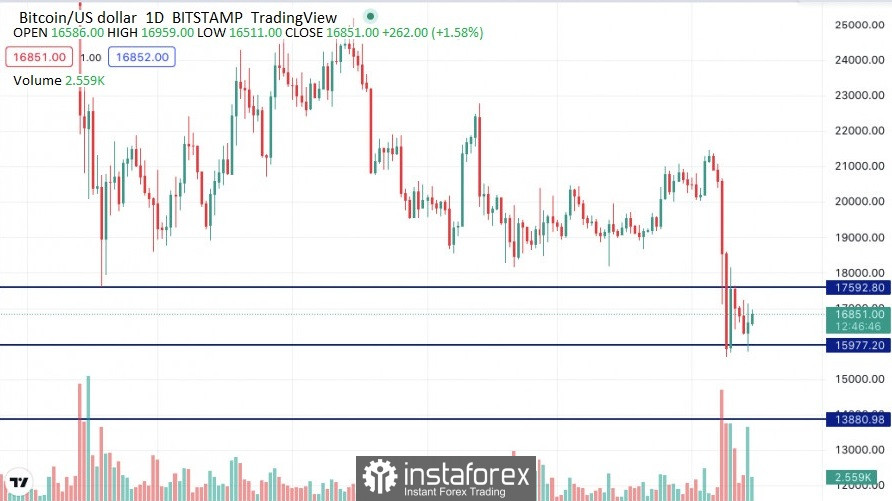The chaos following last week's FTX scandal has seen investors withdraw more than $3 billion worth of BTC from exchanges.
Approximately 190,000 bitcoins have been withdrawn from exchanges in the seven days since news of the FTX liquidity crisis broke, according to Coinglass data. That's roughly $3 billion at the current price of bitcoin.
As the FTX crisis unfolded, concerns began to rise among investors about the safety of their funds on exchanges. Commentators from all walks of life advised users to avoid custodial wallets and control their crypto assets. Since then, regulators have also increased their scrutiny of the crypto industry across the board.
On-chain data shows that investors have withdrawn BTC at a much higher rate over the past seven days, something that has not happened since April 2021. As of November 12, more than 70,000 addresses have been seized.
Glassnode Senior Analyst, Checkmate, noted that exchange balances are best estimated based on wallet clustering. Most likely, this is the lower bound, and not an overestimate.
He added that three exchanges have "particularly odd" bitcoin balance readings - Huobi, Gate.io and Crypto.com. These inter-exchange fund flows include both real customers and FTX/Alameda. They are difficult to separate, so everything looks relatively balanced.
Binance CEO Changpeng Zhao, who was considering buying FTX but backed out after investigating finances, warned that the fallout from FTX could hit another crypto exchange. The comments come after Crypto.com accidentally transferred more than 300,000 Ethereum worth about $360 million from its exchange.
Institutional investors buy back BTC bottom
According to CoinShares, institutional investors are taking advantage of reduced cryptocurrency prices in light of the FTX-driven market crash.
In its latest weekly digital asset fund flow report, CoinShares reports that digital asset investment products posted their highest inflow in 14 weeks.
"Digital asset investment products posted their biggest inflow in 14 weeks totaling $42 million. It started later this week on the back of an extreme price drop triggered by the FTX/Alameda crash."
Bitcoin investment vehicles received the lion's share of capital inflows, adding $19 million last week.
"Bitcoin has been in the spotlight with $19 million inflow, the biggest since early August this year. However, kBitcoin investment products also received $12.6M inflows."
CoinShares has seen inflows from all regions, especially the US, Brazil, and Canada.
"Switzerland was an exception, with a slight outflow totaling $4.6 million, although it remains the country with the largest inflows since the beginning of the year."
Ethereum (ETH) investment products brought in $2.5 million last week, while Solana (SOL) lost $1.1 million and Polygon (MATIC) gained $200,000.
Investment vehicles with multiple assets, or those investing in more than one digital asset, saw their biggest weekly gains since June, according to data from CoinShares.
"Multi assets posted their biggest inflow since June 2022 of $8.4 million, suggesting that investors view it as a relatively safe haven, while there has been very little activity in altcoins."
Meanwhile, bitcoin has retreated from the $15,977-17,592 sideways support level and remains between these limits on Tuesday.

Sellers suffer their biggest total loss since March 2020
Simultaneously, data from network analytics company Glassnode confirms that the bitcoin Production Profit Ratio (SOPR) has now fallen to a two-year low.
As holders of the main cryptocurrency try to withdraw funds from exchanges to non-custodial wallets, those who move coins do so with many years of high losses.
SOPR divides the realized value of coins in a spent issue by their value at creation. In other words, as Glassnode summarizes, it's the ratio between "the sale price and the price that was paid."
SOPR hovers around 1 and tends to be below this level during bitcoin bear markets and above it during bull markets.
This is logical, as unrealized losses increase during the bear market phase, resulting in relatively large total realized losses after the sale of coins.
Thus, the end of a bear market tends to result in a lower SOPR. As of November 14, the seven-day moving average of the index stood at 0.9847, the lowest since the COVID-19 intermarket crash in March 2020.
If BTCUSD starts to rise, holders will have an incentive to sell at cost or slightly higher to avoid losses. This leads to an oversupply, which, without buyers, logically causes the price to drop again.
Thus, SOPR acts as a useful predictive tool for potential price trends.
"Because of the fundamental nature of the underlying metrics that SOPR relies on, it would be fair to assume that the input-to-profit ratio influences price changes," stated Renato Shirakashi, the metric's creator, in his 2019 introduction:
"This could make a big difference as most of the current indicators are lagging."
In March 2020, SOPR briefly dropped to 0.9486, which is still not as low as it was at the end of the 2018 bear market, when it hit 0.9416.
At the same time, it has been observed that those who engage in "buying the fall" do so even on the smallest level. Further data from Glassnode shows that the number of wallets holding at least 0.1 BTC, or around $1,700, has topped 4 million.
 English
English 
 Русский
Русский Bahasa Indonesia
Bahasa Indonesia Bahasa Malay
Bahasa Malay ไทย
ไทย Español
Español Deutsch
Deutsch Български
Български Français
Français Tiếng Việt
Tiếng Việt 中文
中文 বাংলা
বাংলা हिन्दी
हिन्दी Čeština
Čeština Українська
Українська Română
Română

